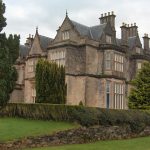 We will be spending two nights in the lovely County Kerry town of Killarney, a favorite place of mine, even though it can get a bit touristy in the summer. Surrounded by gorgeous mountains, forests, and lakes and the gateway to two spectacular drives, the Ring of Kerry and the Dingle Peninsula, Killarney is also known for its excellent restaurants and shops (including an outlet mall). The town is small enough that you can easily walk from one end to the other, and it has a nice selection of music pubs, if you want to hear a bit of Irish music in the evening and have a bit of “craic.” Pronounced CRACK, is the Irish word for “fun,” meaning laughs and good conversation.
We will be spending two nights in the lovely County Kerry town of Killarney, a favorite place of mine, even though it can get a bit touristy in the summer. Surrounded by gorgeous mountains, forests, and lakes and the gateway to two spectacular drives, the Ring of Kerry and the Dingle Peninsula, Killarney is also known for its excellent restaurants and shops (including an outlet mall). The town is small enough that you can easily walk from one end to the other, and it has a nice selection of music pubs, if you want to hear a bit of Irish music in the evening and have a bit of “craic.” Pronounced CRACK, is the Irish word for “fun,” meaning laughs and good conversation.
I have a special love for Killarney because when I was spending a 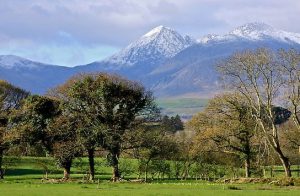 semester working at a primary school in London with my college roommate, we hitchhiked here from Dublin. I remember a wonderful, bitterly cold March weekend of exploring the area on rented bicycles in the rain. I had never been so cold, or so happy being cold. My friend and I had not done any research on this locale, taking the word of an acquaintance who lived in Dublin before setting out, and when we realized where we were and what we had before us, we couldn’t believe our luck. There were castles and abbeys and manor houses galore, breathtaking views in all directions, jagged coastline and wild seas, and everything else we had expected Ireland to offer.
semester working at a primary school in London with my college roommate, we hitchhiked here from Dublin. I remember a wonderful, bitterly cold March weekend of exploring the area on rented bicycles in the rain. I had never been so cold, or so happy being cold. My friend and I had not done any research on this locale, taking the word of an acquaintance who lived in Dublin before setting out, and when we realized where we were and what we had before us, we couldn’t believe our luck. There were castles and abbeys and manor houses galore, breathtaking views in all directions, jagged coastline and wild seas, and everything else we had expected Ireland to offer.
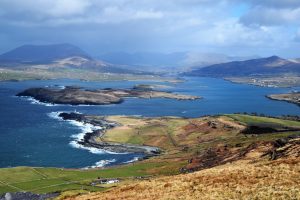
Hitchhiking around the Ring of Kerry one day, we were picked up by the local school bus, which was really just a covered truck with a lot of hay and seven or eight redheaded children in the back. It was a different time. The fanciest accommodation in town was the “Great Southern,” an elegant nineteenth-century railway hotel that is still there, though now called by another name. We couldn’t afford to stay in such splendor, but the exchange rate was so favorable that even on our student budgets we could afford a sumptuous dinner in the grand dining room. I’m quite sure we imagined ourselves in a Victorian novel that evening. I only spent a week in Ireland on that trip and only four days in Killarney, but everything about the experience had me hooked for life, and when I made my first return trip fifteen years later, I dragged my whole family to Killarney. They were also hooked.
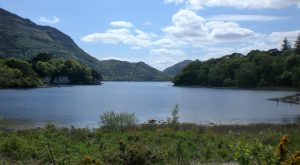
Like most towns in Ireland, Killarney started as a religious settlement with several ancient church sites, and there are still remnants of buildings going back to the twelfth century. The name comes from the Irish “cill airne” or “church of the sloes,” referring to blackthorn trees. Killarney is surrounded by forests, unlike much of the country, thanks to its vast sources of lumber being commandeered for the building of the British fleet. The town sits at the base of Ireland’s tallest mountains, McGillycuddy’s Reeks, at just over 1,000 metres or 3,300 feet. The three famous “Lakes of Killarney” and countless waterfalls and streams add to the picture, and for centuries poets, artists, tourists, and at least one monarch, Queen Victoria, have been enthralled with the views.
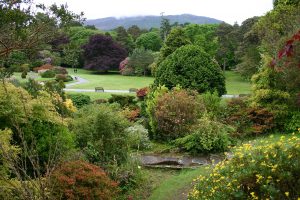
Queen Victoria arrived with her entourage in August of 1861, only a few months before her life would change forever with the sudden death of her husband Prince Albert. She had already made several state trips to this part of the empire but had never gone as far west as Kerry. The couple reportedly enjoyed their time in Killarney and the hospitality of the Herbert family, owners of the splendid Muckross House, which is included on our visit. I don’t think anyone will disagree with me when I say that the setting of this house–on the shores of Lough Leane with mountains all around–is the most beautiful in Ireland, and the grand mansion isn’t bad either. The Herberts had spent the previous six years preparing for the queen’s visit, redecorating the house from top to bottom and running themselves into financial ruin in the process. We’ll see some of the splendid furniture and decor they provided for Her Majesty, valuing the success of the royal visit over their future financial security. After the Herberts, the house passed into other hands and was eventually gifted, along with its substantial parklands, to the Irish nation in 1932. And what a gift it was. Ireland’s first national park was established here, more land was added later, and the beautiful house and gardens were saved from ruin with painstaking conservation funded by the state.
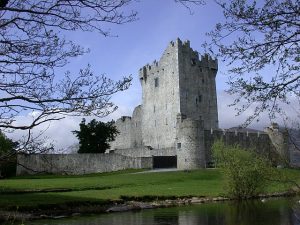
We’ll see the national park from several perspectives, including bouncing along its automobile-less roads in a jaunting car—the horse and buggy conveyance unique to this area. The slow pace of the horse and the driver’s characteristic badinage set the mood for enjoying the beautiful lakes and woods, Ireland’s only herd of native red deer, and the wildflowers and other wildlife that thrive here in this oldest of Ireland’s national parks. The jaunt includes a stop at Ross Castle, a sturdy fifteenth-century Norman keep on the shores of Lough Leane. The castle is noted for being the site of last stronghold against Oliver Cromwell in all of Munster in 1652.
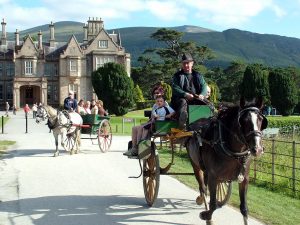
In addition to seeing Muckross House and the national park, we’ll use Killarney as our base for visiting the Dingle Peninsula. The drive there is long-ish, so use your time brief free time in Killarney well to stroll about the town and into the park, check out the shops, and dine in one of its stellar restaurants.
County Kerry is famous for being the home of numerous rebels and ambushes during the independence struggle 1916 to 1923; there are memorials everywhere. And the county as a whole is mad crazy for Gaelic football, winning the All-Ireland championship four out of the last ten years. I can’t close without saying a word about the Kerry accent or dialect, which I hope you will hear when we’re in Killarney. It’s easy to distinguish this rapid, “bubbling,” lilting way of speaking from other accents and difficult, even for Irish people sometimes, to understand what the heck is being said. I couldn’t find a good audio clip of just the Kerry way of talking online, but for some extra “craic,” listen to this short clip on Irish accents in general, which dubs the Kerry accent the “crown jewel.”
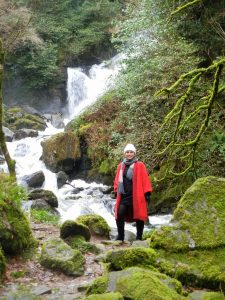

Christine,
Thank you for all of your comments. Invaluable as we get ready! This blog on Killarney is wonderful as is the link to all of Ireland’s accents!
Glad you enjoyed it, Barbara!